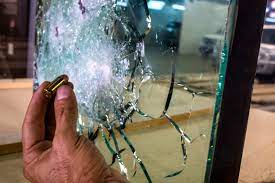McBRG (Bullet Resistance Glass)
Bullet Resistant Glass

Bullet-resistant glass is usually constructed using a strong but transparent material such as polycarbonate thermoplastic or by using layers of laminated glass. The desired result is a material with an appearance and light-transmitting behavior of standard glass but offers varying degrees of protection from small arms fire.
No glass is BULLET PROOF, in fact it is anything but bulletproof.
Bullet-resistant glass is also sometimes referred to as bullet proof glass. Technically speaking, bulletproof glass would be glass that is capable of stopping most manner of bullets fired at it. Such glass cannot currently be made in any usable thickness (if at all), so what is loosely called bulletproof glass is, within the industry, referred to as bullet-resistant glass.
Bullet-resistant glass constructed of laminated glass layers is built from glass sheets bonded together with polyvinyl butyral or polyurethane. This type of bullet-resistant glass has been in regular use on combat vehicles since World War II; it is typically about 100–120 mm (3.9–4.7 in) thick and is usually extremely heavy.
Composite glass constructions feature a combination of polycarbonate, acrylic, PET, and enhanced performing PVB Interlayers. No spall and increased ballistic/anti vandal properties ensure superior performance consistently.
Typical Applications
- Security Doors
- Banks
- Safe Rooms
- Prisons
- Embassies
- High Security Buildings
- Guard Houses
Features and Benefits
- Improved ballistic performance
- Enhanced safety and security
- Acoustic Insulation


